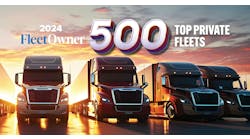2025 FleetOwner 500: For-Hire sees significant carrier shifts
The annual FleetOwner 500: For-Hire list ranks the largest motor carrier and commercial fleet operations in the United States. As the trucking industry continues to claw its way back from the post-pandemic freight recession and adapt to new business trends and technologies, we saw several changes to this list that FleetOwner has been producing for decades.
While the five largest for-hire carriers operating in the U.S. remain unchanged on the 2025 FleetOwner 500: For-Hire list, you'll find significant movements among the other 495 ranking spots, such as Pitt Ohio's 19-spot jump into the Top 50 and Kriska Transportation's 297-spot leap into the Top 200.
General freight and less-than-truckload carriers continue to dominate the 50 largest for-hire fleets. LTL giant Yellow's bankruptcy in 2023 created opportunities for carriers such as Estes Express, which has gobbled up much of Yellow's network over the past 18 months. Estes debuted in the Top 10 last year at No. 9 and moved up another slot to No. 8 in 2025.
There could be more LTL movement in the coming year as FedEx, the longtime FO500 No. 1 fleet, considers spinning off its LTL freight business (and its 30,000-plus power units) into its own entity. Until then, rival UPS holds the No. 2 spot, while Knight-Swift, J.B. Hunt, and R+L Carriers round out the top five.
The following pages show how each company's 2025 ranking compares to 2024. They also list the total number of commercial power units, trucks, tractors, trailers, and registered operating types. We also break these down into Top 10 lists focusing on business categories: bulk, refrigerated, construction, and more.
This year, the FO500 will include 54 new companies, including five fleets that fell off the list but are back.
The FO500 is our annual snapshot of the dynamic, competitive trucking industry. The shifts in rankings reflect how trucking companies are evolving with shifting market demands and the post-pandemic supply chains.
See also: FleetOwner 500: For-Hire 2024
Methodology
This is the third FleetOwner 500: For-Hire list since revising how we gather the data that makes our lists. Since 2023, we have partnered with the analysts at ProsperFleet, which primarily relies on the most recent information companies filed on form MCS-150 with FMCSA to count power units, trailers, and drivers. This ensures a consistent playing field for all carriers operating in the U.S.
Analysts at ProsperFleet also use the companies' websites, press releases, and hierarchy from their business databases to roll USDOT operating entities into a single parent company. ProsperFleet then cleanses, validates, standardizes, and enhances company and contact information to create a complete fleet view.
For companies with subsidiaries and divisions with USDOT numbers, the vehicle counts of the subsidiaries are in the parent company's total on the FO500.
Below is an interactive display of the 2025 FleetOwner 500: For-Hire list. You can re-sort the list by each column and see how this year's FO500 rankings compare to the 2025 FleetOwner 500: For-Hire.









